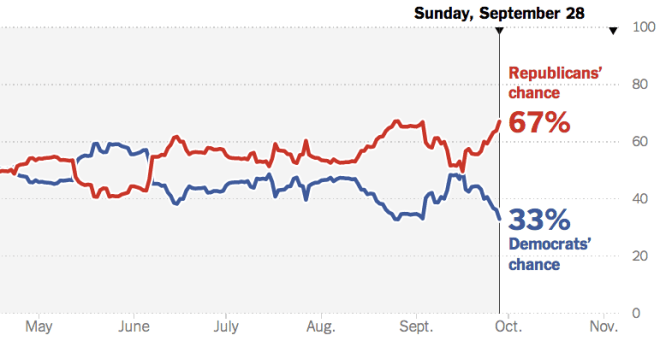At least that’s what the NYT’s forecast shows:
Nate Cohn analyzed the state of affairs on Friday:
Four consecutive surveys have shown Cory Gardner, the Republican candidate in Colorado, in the lead. Two nonpartisan polls — the only two of the last three weeks — showed Dan Sullivan, the Republican candidate in Alaska, also in the lead. The Republicans have not held a consistent lead in Iowa, but the Democrats haven’t led any of the last three polls there, either. As a result, Leo now makes Republicans slight favorites in these states — and that’s the main reason the fight for Senate control has drifted toward the Republicans.
Silver asks, “So what conditions would merit outright panic from Democrats?”:
They should keep a close eye on North Carolina and Kansas. These states have been moving toward Democrats in our forecast, helping them offset Republican gains elsewhere.
But these are also races in which the Democrat is doing better than the “fundamentals” of the states might suggest. The Democratic incumbent in North Carolina, Kay Hagan, is pretty clearly ahead in the polls today (including in a CNN survey that was released on Sunday). However, two other states with vulnerable Democratic incumbents, Colorado and Alaska, have shifted toward Republicans. Perhaps if the Republican challenger Thom Tillis can equalize the ad spending in the Tar Heel State, the polls will show a more even race there as well.
And the Kansas race is still in its formative stages.
Molly Ball profiles Greg Orman, the independent running in Kansas:
Control of the Senate could hinge on this unlikely contest between an insistently nonpartisan, Ivy League-educated former consultant and a Republican incumbent who’s spent 33 years in Washington. If elected, Orman says he would caucus with whichever party has the majority. But if there are 50 Republicans and 49 Democrats, he would play tiebreaker: Joining the GOP would give them 51 votes; joining Democrats would give them 50 votes plus the vice president. In that case, Orman says, he would ask both parties to commit to issues like immigration and tax reform, and join the one that agreed. “We’re going to work with the party that’s willing to solve our country’s problems,” Orman said in an interview.
Almost every ballot has an independent or third-party candidate who blames the two major parties for America’s problems. Most of them are flakes or gadflies who go unnoticed. But Orman has money, he’s run a smart campaign, and he seems to be in the right place at the right time. A weak Republican incumbent, a Democrat willing to get out of the way, and a state whose Republican majority has been badly split by years of toxic intraparty battles—all these factors have made Kansas uniquely receptive to Orman’s message.
Andrew Prokop watches as the various forecasts come into agreement:
In early September, there was an evident split among the six main Senate forecasts. Those that used only polls of individual races — HuffPost Pollster, Daily Kos, and Princeton Election Consortium — showed a small Democratic advantage. But those that also incorporated factors called “fundamentals” —FiveThirtyEight, the Upshot, and the Washington Post — gave the GOP a lead. (These “fundamentals” can include both state-level factors like candidate fundraising and how the state voted in the 2012 presidential race, as well as national factors like the generic ballot.)
Now, though, that split is gone — two of the polls-only models also give the GOP a lead …
